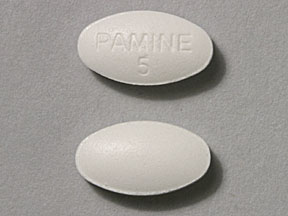Pamine Forte Interactions
There are 201 drugs known to interact with Pamine Forte (methscopolamine), along with 17 disease interactions, and 2 alcohol/food interactions. Of the total drug interactions, 5 are major, 179 are moderate, and 17 are minor.
- View all 201 medications that may interact with Pamine Forte
- View Pamine Forte alcohol/food interactions (2)
- View Pamine Forte disease interactions (17)
Most frequently checked interactions
View interaction reports for Pamine Forte (methscopolamine) and the medicines listed below.
- Abilify (aripiprazole)
- Accupril (quinapril)
- acetaminophen / hydrocodone
- Actiq (fentanyl)
- Adderall (amphetamine / dextroamphetamine)
- albuterol
- albuterol / ipratropium
- allopurinol
- Anaprox-DS (naproxen)
- Anusol-HC Suppositories (hydrocortisone topical)
- Aspir-Low (aspirin)
- aspirin
- atenolol
- Cardizem (diltiazem)
- Flomax (tamsulosin)
- Flonase (fluticasone nasal)
- Lipitor (atorvastatin)
- lisinopril
- Norvasc (amlodipine)
- Phenergan (promethazine)
- Plavix (clopidogrel)
- prednisone
- Prilosec (omeprazole)
- Protonix (pantoprazole)
- Synthroid (levothyroxine)
- Topamax (topiramate)
- Valium (diazepam)
- Vitamin D3 (cholecalciferol)
- Xanax (alprazolam)
- Zyrtec (cetirizine)
Pamine Forte alcohol/food interactions
There are 2 alcohol/food interactions with Pamine Forte (methscopolamine).
Pamine Forte disease interactions
There are 17 disease interactions with Pamine Forte (methscopolamine) which include:
- autonomic neuropathy
- GI obstruction
- glaucoma
- obstructive uropathy
- reactive airway diseases
- myasthenia gravis
- infectious diarrhea
- cardiac disease
- tachycardia
- coronary artery disease
- gastric ulcer
- gastroesophageal reflux
- ulcerative colitis
- hypertension
- hyperthyroidism
- diarrhea
- fever
More about Pamine Forte (methscopolamine)
- Pamine Forte consumer information
- Compare alternatives
- Reviews (4)
- Drug images
- Side effects
- Dosage information
- During pregnancy
- Drug class: anticholinergics/antispasmodics
- Breastfeeding
- En español
Related treatment guides
Drug Interaction Classification
| Highly clinically significant. Avoid combinations; the risk of the interaction outweighs the benefit. | |
| Moderately clinically significant. Usually avoid combinations; use it only under special circumstances. | |
| Minimally clinically significant. Minimize risk; assess risk and consider an alternative drug, take steps to circumvent the interaction risk and/or institute a monitoring plan. | |
| No interaction information available. |
See also:
Further information
Always consult your healthcare provider to ensure the information displayed on this page applies to your personal circumstances.


